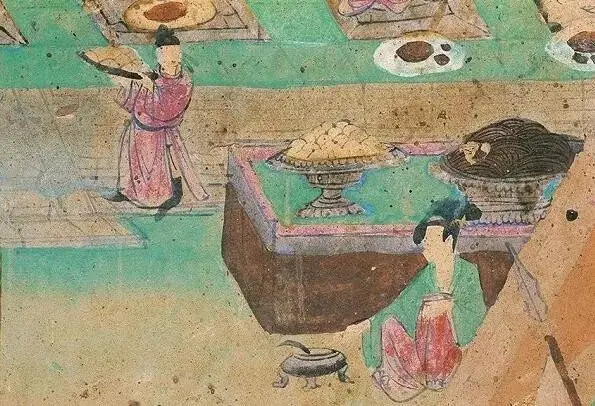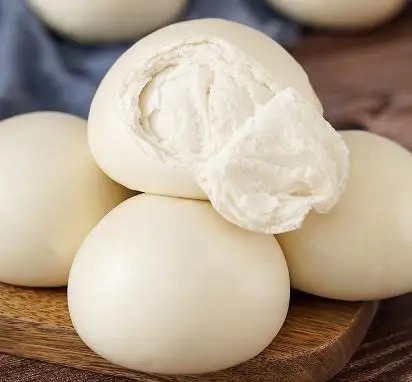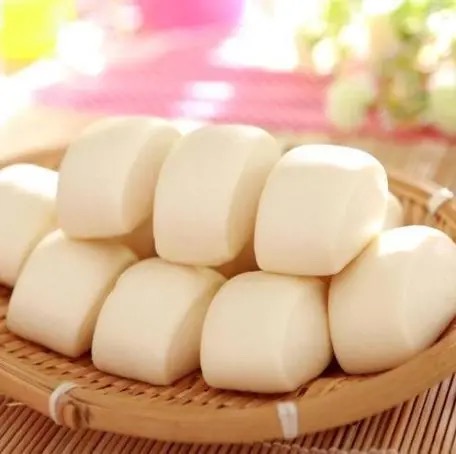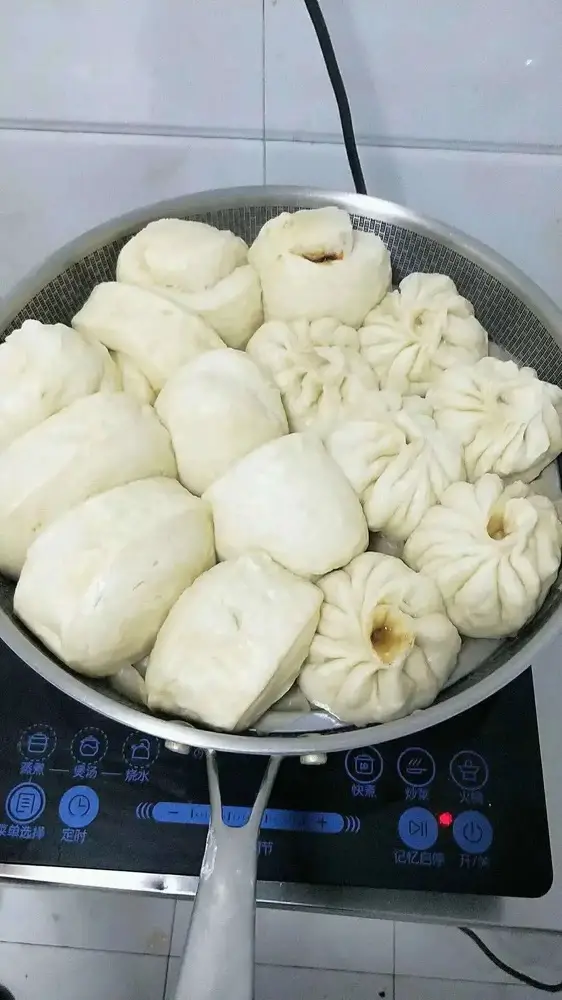Mantou bun is a white and soft type of steamed bread, made from wheat. It is the staple food in the northern China where wheat is often grown and almost 70% of flour production in the entire region is used to make mantou. There are two types of mantou, the hard one that measures about 15 centimeters for the work men’s lunch and soft, chewy, fluffy, milk aromatic ones measuring about 4 centimeters for those living in the first lane of life. They are sold in a frozen precooked form and upon purchase, steamed or heated in the microwave oven.
What is mantou bun made of?
Mantou’s main ingredient is the white wheat flour, but other ingredients can always be added to it like sweet potato, pumpkin and corn flour. Yeast and baking powder are both used to make the cooking process not only easier but also faster. Salt is added to taste. Brown sugar and food coloring are usually used in mantou making especially for special occasions.
Mantou history

Mantou is said to have emerged during the Zhou Dynasty (1046-771 BC) in Eat China. “Mantou” means a barbarian’s head according to a popular story about Zhuge Liang, a military leader who wanted to cross the Lu River that had big stormy waves together with his army. The locals advised him that he had to appease the river by offering sacrifices of 50 barbarian’s heads and throwing them into the river. He did not want to lose any of his men, so he came up with a brilliant idea. He ordered his men to kill livestock, fill their meat into a floor dough shaped like human head and threw them into the river. The river was appeased and they passed, he named the bun barbarian’s head and so the origin of ‘mantou’.
Mantou’s existence dates to a more than 2000 years ago as they are mentioned in texts as early as during the period of Warring States in China. Mantou has evolved over time and continued to be a star or a supporting cast in the food culture of the Chinese.
Who invented mantou?
Zhuge Liang of the 3rd Century is credited by historians to be responsible for the invention of mantou. Zhuge was a military strategist and had won the famous Southern Campaign battle to squash the rebellion of barbarians. He, together with his people were at the brink of crossing a river that was believed to be guarded by deity and had strong waves, when the locals in the region advised him that he had to appease the deity in order to have a safe passage across. This was such an enormous logistical challenge. The advice was that he was supposed to slaughter 50 of his soldiers and throw their heads into the river as a sacrifice. Zhuge Liang did not want to lose more of his soldiers as he had come from the battle. He masterminded a plan that would both appease the deity and save the lives of his soldiers. He therefore ordered for 50 buns to be made in a way that they resembled human heads, with round shapes and flat bases.
They then killed livestock and stuck the meet inside the buns and threw them into the water. The trick planned and they had a safe passage. In celebration of the victory, he named the buns Mantou which means barbarian’s heads. This celebration extended to the people as they celebrated the victory against the barbarities of bad lunch. From this time, mantuo buns were made frequently and became a staple food, maybe because the celebrations went for long.
How to make mantou bun

Mantou is usually round, but for New year festive seasons, it can assume all manner of shapes like butterflies or even flowers.
There are two methods for preparing Mantou, one being the yeast only method and the other using both yeast and baking powder. The former makes great Mantou if the double -proofing procedure is used. This method involves leaving the dough to rise until it becomes twice the initial size. Shape the buns individually and then let them raise again before steaming. This resting time may take a minimum of 1 hour to a maximum of two hours and is determined by the room temperature. The latter method (yeast and baking powder) requires only one proofing process. The buns are shaped right after the dough is made and allowed to rise for approximately 30 minutes before steaming or heating by microwave oven. This method is the simpler and more efficient of the two.
How to make the dough
The quality of the final product depends on how the dough is made. If the dough is made correctly, the end product should be a soft, fluffy, chewy and flawless bun.
Ingredients
250 g of white wheat flour
5 g of salt or to taste.
15 g sugar or to taste.
14 0g of water at room temperature (25°C)
3 g of baking powder
10 g of cooking oil.
Procedure

Mix the wheat flour, cooking oil, yeast and baking powder while adding water gradually. Leave the combination to rest for a few minutes and then knead the combination into a medium-firm dough. You can either do it by hand or use a standard mixer and then finish the process by the hand. It should neither stick to the hands nor the working surface.
At this stage, you can shape the buns into whichever form you want, be it the round, the flower shape or butterfly-like shape, but you have to first of all divide the dough into small equalizes according to your preferences, either small, medium or large.
The regular round shape buns are made by kneading and folding the dough towards the center of the ball without turning over. Rotate the ball in between your pals to form a slightly raised shape.
Once this process is done, put the buns in a in a steamer basket, leaving enough space in between and let them rest for about 30 minutes in a room temperature of 25° C or more in a colder place. The dish buns are ready, enjoy!
To produce flawless look, avoid over proofing the buns as longer time causes excessive air that collapses when the heating ends.
How to eat mantou
Mantou, being the staple food in Northern China is used as a common breakfast item. You can cut it open and put a fried egg in between and eat it as a burger or you can spread some savory sauce. Mantou is often served with several savory dishes and accompanied by congee or a soup.
You could also dip it into condensed milk or honey. All of this is yummy.
Why mantou is hard
Your mantou can be really hard especially after cooling down which is disgusting as many a people prefer it fluffy, chewy, aromatic milk, soft with flawless appearance that is appealing and its surface flat and not fallen. The reason this happens is as a result of mere approximations and failure to follow the exact quantities of the ingredients. The amount of water can be given in grams but you don’t have a way to measure that so you approximate it in milliliters and this is likely to be responsible for the hardness. It is important that you follow the procedure carefully with special emphasis in the quantity.
Another reason for the mantou not being fluffy is that it was under proofed or the kneading wasn’t done sufficiently.
Difference between bao and mantou

Bao, derived from baozi indicates filled buns while mantou refers to plain bread. Bao is referred to as the working man’s lunch while mantou is luxurious food found in high-end restaurants. Mantou is more processed, unlike bao which used simple techniques. Mantou is more expensive than bao which is commonly available.
Bao is usually round in shape with a flat base and has lots of red or yellow to identify its fillings while mantou is plain with no filling and is round with both sides flat. These differences are however not universal and vary from place to place. In some regions, bao and mantra are used interchangeably.
Mantou vs bread
Mantou and bread have been enjoyed by humans for hundreds of years. Mantou, or Chinese steamed buns, are a staple food in China, just as bread is in many parts of the world. These two foods may have some similarities, but there are also important distinctions between them.
Traditional ingredients for mantou include wheat flour, yeast, sugar, and water. Because steaming, rather than baking, the dough, it results in a light and airy texture. In addition to being used as a bun for sandwiches and burgers, mantou is also commonly eaten as a side dish. Instead, bread is baked in an oven after being prepared with flour, water, yeast, and salt. Bread comes in a wide variety of flavors and textures, from white to whole wheat to sourdough and beyond.
The texture of mantou is very distinct from that of bread. Compared to bread, mantou has a lighter texture and airier texture. The addition of sugar to the dough makes mantou typically sweeter than bread. The typical loaf of bread, on the other hand, does not have any sugar added to it.
The way that mantou is consumed also sets it apart from bread. Mantou can be used as a bun for sandwiches or a side dish for savory meals. Bread, on the other hand, is versatile enough to be enjoyed on its own, as a sandwich component, or with other toppings and spreads.

Conclusion
Mantou is the staple food in Northern China where wheat is grown in large quantities to supply the large population. It is the commonest food in Chinese tables where it is used for breakfast or together with soups. Mantou has a rich and long history dating back to 2000 years ago, but has evolved over time and maintained its place as the staple food in Northern China. You might want to try out this mantou bun for this year’s End Year celebrations instead of the usual rice. Serve it with your favorite soup or eat it as a burger.